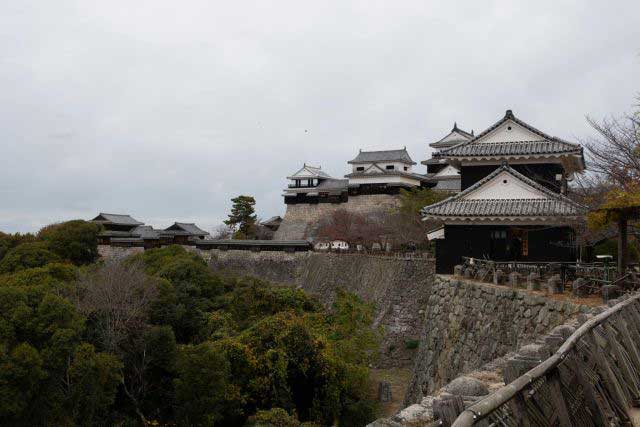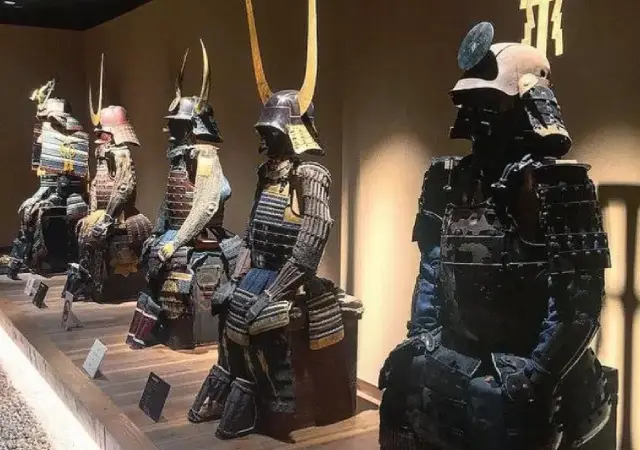
Takatenjin Castle was a yamashiro-style fortress from Japan's Sengoku period, situated in the Kamihijikata and Shimohijikata districts of Kakegawa, Shizuoka Prefecture. Designated a National Historic Site in 1975, with an expanded protected area in 2007, its ruins remain a significant historical landmark.
The castle stood on Mount Kakuo, a 200-meter-high mountain with steep cliffs, accessible only via a narrow path. Strategically important, it was considered the "key" to controlling Totomi Province and the nearby Tokaido highway, which lies 11 kilometers to the south. The castle's layout formed a "Z" shape, spanning the eastern and western peaks of the mountain, with a saddle-like ridge connecting the two. The eastern peak contained the original fortifications, including the inner bailey, while the western peak was added later by the Takeda clan. The castle was surrounded by terraces, dry moats, and earthen ramparts. Despite lacking stone walls, its steep terrain made it nearly impregnable.
The exact origins of Takatenjin Castle are uncertain, but it is believed to have been built by the Kushima clan in the 15th century. The Kushima were retainers of the Imagawa clan, but were eventually suppressed after siding against Imagawa Yoshimoto in an internal struggle. Yoshimoto later gave the castle to the Ogasawara clan. During the Battle of Anegawa in 1570, Tokugawa Ieyasu controlled the castle, leaving Ogasawara Nagatada as its castellan.
In 1571, Takeda Shingen besieged Takatenjin Castle with 20,000 troops but failed to capture it. Three years later, in the Siege of Takatenjin (1574), Takeda Katsuyori succeeded where his father had not, capturing the castle and earning great prestige. However, the victory was short-lived as the Takeda suffered heavy losses the following year to the Oda-Tokugawa alliance. By 1580, unable to maintain supply lines to the castle, Tokugawa Ieyasu decided to isolate it rather than attack directly. The defenders, running out of supplies, made a desperate attempt to break the siege in March 1581, led by their commander Okabe Motonobu. All 700 men were killed, and the castle was abandoned soon after.
Today, the city of Kakegawa preserves the castle ruins, with several hiking trails leading up the mountain. The summit hosts a Shinto shrine and monuments honoring the war dead from the Satsuma Rebellion and the First Sino-Japanese War. A faux tenshu (main keep) built before World War II was destroyed by lightning, leaving only a concrete foundation behind.
See also
-
Iyo Matsuyama Castle

Historically, the center of Iyo Province—corresponding to today’s Ehime Prefecture on the island of Shikoku—was the city of Imabari, while the Matsuyama area was regarded as an agricultural hinterland with broad plains and low hills. During the Muromachi period, the central part of the province was governed by the Kano clan from Yuzuki Castle. With the onset of the Sengoku period, however, this clan lost its former influence and was forced to survive in the shadow of the more powerful Mori and Chōsokabe clans. After Toyotomi Hideyoshi’s forces conquered Shikoku in 1587, the northern part of Iyo Province was granted to Fukushima Masanori, one of the so-called “Seven Spears of Shizugatake.” In 1595, Masanori was transferred to Kiyosu Castle, and the lands around Matsuyama were given to another of the Seven Spears, Katō Yoshiaki, who received Masaki Castle and an income of 60,000 koku of rice.
-
Kanazawa Castle

Construction of Kanazawa Castle began in 1580 on the orders of Sakuma Morimasa, a vassal of Oda Nobunaga. The castle was built on the site of the Ikko-ikki sect's Oyama Gobo temple, which is why it is sometimes called Oyama Castle. Morimasa managed to build several moats and begin construction of a castle town. However, after his defeat at the Battle of Shizugatake in 1583, he was executed, and ownership of the castle passed to Maeda Toshiie (1538–1599).
-
Nakatsu Castle

Kuroda Yoshitaka (1546–1604) was one of the closest advisors to the legendary military commander Toyotomi Hideyoshi. He took part in key military campaigns of the late 16th century, including the campaign against Shikoku in 1585 and the campaign against Kyushu in 1587. Later, during the second campaign in Korea, Yoshitaka served as chief advisor to the commander of the invasion forces, Kobayakawa Hideaki. After Hideyoshi's death, he swore allegiance to Tokugawa Ieyasu, thereby securing his influence and patronage under Japan's new leader.
-
Edo Castle

The history of Edo Castle dates back to the Heian period, when the Edo clan built a small fort on this site. In 1457, the vassal of the Uesugi clan, Ota Dokan (1432–1486), constructed a full-scale castle here. Internal conflicts weakened the Uesugi clan, and in 1524, Ota Dokan’s grandson, Ota Yasutaka, surrendered the castle without resistance to the forces of Hojo Soun, the ambitious leader of the Hojo clan. While Odawara Castle remained the clan's main stronghold, Edo was considered a key strategic fortress.
-
Samurai Museum Shinjuku

Situated in the vibrant district of Shinjuku, the museum showcases an extensive collection of samurai armor, weapons, and cultural artifacts spanning from the Kamakura to the Edo period. The exhibits aim to convey the samurai's unwavering commitment to honor and discipline, reflecting how their spirit continues to influence modern Japanese culture.
-
Anjo Castle

Anjo Castle was built on a slight elevation at the edge of the Hekikai Plateau, about 2 kilometers southeast of present-day central Anjo City in Aichi Prefecture. Today, the surrounding area thrives on large-scale agriculture and automotive manufacturing, utilizing the expansive flatlands and its proximity to the Nagoya region.
-
Numata Castle

Numata Castle, located in Numata, northern Gunma Prefecture, Japan, has a rich and complex history. During the late Edo period, it served as the residence of the Toki clan, who ruled the Numata Domain. Over the centuries, the castle changed hands multiple times and was the site of significant battles during the Sengoku period.
-
Iwabitsu Castle

Iwabitsu Castle is a yamashiro-style (mountain) castle located atop Mount Iwabitsu in Higashiagatsuma, Gunma Prefecture, Japan. Recognized for its historical significance, its ruins have been protected as a National Historic Site since 2019.

